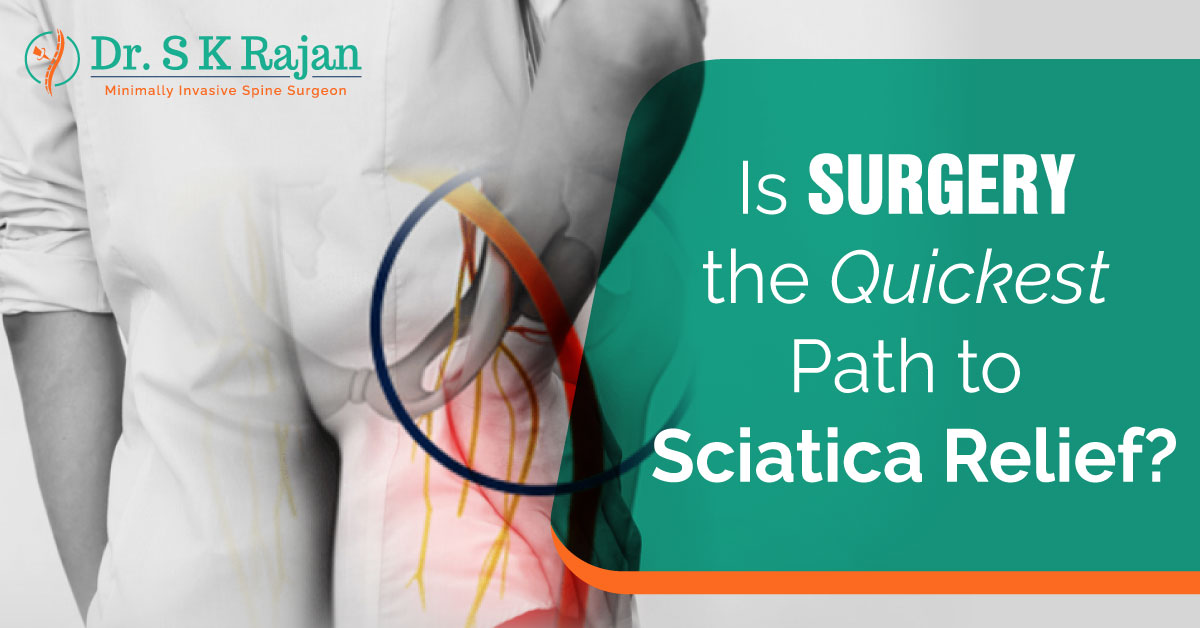
The sciatic nerve runs from the back of the pelvis down the back of the thigh and is the source of sciatica.
Non-surgical and non-invasive methods can alleviate sciatica pain. The cramping, shooting pain, or electrical jolt they feel down the back of their legs can be unbearable for some patients.
Even if you've tried everything else, including prescription drugs, exercise, acupuncture, and other medical and non-medical treatment, it may not be in your best interest to wait it out. Recent studies have shown that surgery can provide long-term pain relief sooner if pursued earlier than previously thought.
The most common symptom of sciatica is pain radiating down the back of your leg from your lower spine. An ache or even a burning sensation can be felt as the result of an injury to the nerves in the back. The pain can be excruciating, while shock-like feelings are common for others. Sitting for long periods can exacerbate symptoms that affect only one side of your body. Another symptom is:
Some people have a wide range of symptoms, while others only have pain or numbness to deal with
After diagnosing sciatica, your doctor will discuss sciatica treatment options with you. Physical therapy, medications, therapeutic injections, and alternative therapies may all be used to find the most effective combination for treating this condition and its accompanying pain. Before recommending surgery, most doctors prefer to see a non-surgical solution first.
Patients should consider surgery if they fall into one of the following categories:
Before recommending surgery for sciatica, your doctor will recommend initial treatments, track progress, and reassess your symptoms and causes.
According to research, patients who have surgery have better outcomes than those who use non-surgical treatments. However, the correct type of surgery can only be performed if a proper diagnosis has been made. The correct procedure can only be achieved if the medical cause of sciatica is known. Further studies show that after a year or two of recovery, patients who underwent surgical or non-surgical treatment see similar long-term outcomes.
To alleviate your sciatica pain, your Dr SK Rajan surgeon will choose the correct surgery based on your specific condition and your doctor's recommendation. Compared to other ways to treat sciatica that don't involve surgery, surgery gives almost immediate pain relief.
Microdiscectomy – Surgery to remove the herniated portion of the disc pressing on the sciatic nerve is known as a microdiscectomy, also known as a micro decompression. To perform a microdiscectomy, a small incision near the spine must be made. Patients are sent home the same day and advised to begin walking as soon as possible following their procedure.
Endoscopic Laminectomy – Sciatic nerves are not compressed during an endoscopic laminectomy procedure because the lamina is cut open to allow nerve passage. Seventy-five percent to ninety percent of patients report immediate relief from sciatica pain after a laminectomy.
Foraminotomy – Neuroforamen (the spaces on either side of the spine that allow spinal cord nerves to travel to other body parts) are widened in a foraminotomy so the sciatic nerve can pass through without being compressed. Bone is typically removed from the vertebrae to accomplish this.
Facetectomy – By removing the facet joints of the vertebrae, a facetectomy frees the sciatic nerve from the pressure that has built up due to degeneration. Nerve compression is alleviated by removing or reducing the joints, as appropriate. A facetectomy relieves about 85-75% of patients who have it.
Sciatic nerve laser surgery – The sciatic nerve can be surgically treated with a laser to remove tissue, putting pressure on it.
For these procedures, complications are infrequent. Nerve damage, infection, and blood clots are unlikely outcomes. Within two to four weeks, most patients can return to work or their daily routines without any strenuous activity. Patients can return to strenuous physical activity within six to eight weeks. You should be able to sit up and walk within 24 hours, even if the healing process is slow. The best way to speed up your recovery is to follow your surgeon's instructions and take pain medications as prescribed.
Be aware of the risks and complications of surgery for sciatica as a last resort. Make sure this is the best treatment option for you by consulting with your doctor.